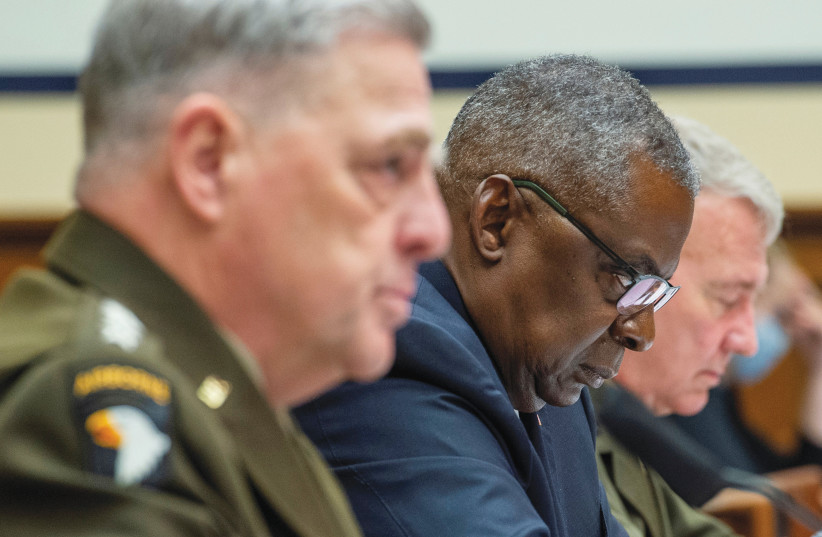The chairman of the US Joint Chiefs of Staff, Mark Milley, recently described the current phase of the war in Ukraine as a “very severe battle of attrition, almost World War I-like.” This description of the reality of the conflict implies key aspects that deserve attention. Milley’s statement was not accidental.
It was made while standing next to US Secretary of Defense Lloyd Austin during their recent visit to Brussels. His message was on target and is consistent with changes in US strategic planning to resolve the conflict in Ukraine. Milley revealed a vision in full agreement with the American approach to change the realities of the military conflict on the ground at any cost.
Although he acknowledged that “the numbers clearly favor the Russians,” he noted that “there are no inevitabilities in war.” This differs markedly from statements he made to the US Congress in February, in which he stroke a downbeat tone. He predicted that within 72 hours of the start of the Russian military operation, he would assess the results of the fall of the Ukrainian capital, Kyiv.
But now, three months into the war, he backtracked. He admired the struggle of Ukrainians “street-by-street, house-by-house,” noting the need “to prevent large powers from conquering smaller countries.” This last statement is in line with the general mood in Washington, which lately considers the possibility of a decisive military strike against Russia in Ukraine very likely.
But this statement may be at the heart of a new strategic principle that will guide US military doctrine in the years ahead. It might imply radical changes that we will see in US strategic plans and orientations.
It may be relevant to US policy in our region, which was the scene of many operations by the US military, whose beliefs seem to be changing and being reshaped by new circumstances and variables. Milley has clearly acknowledged his country’s defeat in the war against the Taliban.
In a lengthy hearing in the US House of Representatives, he said it had become clear that his country was fighting a losing war in Afghanistan and attributed what he called a strategic defeat to a long series of decisions. “We accomplished our strategic task of protecting America against Al Qaeda, but certainly the end state is a whole lot different than what we wanted,” he deplored.
This statement seems to have factored into the US chief of staff’s belief that the conflict between large and small is over. US enthusiasm for weakening Russia in Ukraine and inflicting a strategic defeat on it was evident: The US “wants to see Russia weakened” to the point where it cannot repeat its actions in Ukraine, Defense Secretary Lloyd Austin said.
THESE WORDs were backed up by the provision of nearly $55 billion in aid to Ukraine since the beginning of the war to keep the country fighting long into the future. That is, to weaken Russia as much as possible and wear down its army, even if the war ends to its military advantage.
This also explains Washington’s desire to accelerate the delivery of weapons that are in the experimental or prototype stage, such as high-tech drones like the Kamikaze Switchblade drone, which are still under development. Undoubtedly, US think tanks have recently made rapid progress in developing a concrete definition of Russia’s strategic failure in Ukraine.
This is not because the US government has not yet formally expressed its vision of a strategic defeat of Russia. Perhaps it is because US objectives change depending on the course of military operations on the ground or the administration’s preference for a shifting scope of action depending on the circumstances of the military conflict in Ukraine.
It also wants to avoid the impression that it is imposing limits on Ukrainian resistance at the expense of the Ukrainian position and angering European allies, who may have a relatively different scenario for ending the war in Ukraine, as they are heavily influenced by the continuation of the conflict.
The important point for me as a researcher in all of this, as I mentioned earlier, is that Milley’s words about the consequences of conflict are large and small, not just because they come from the military command responsible for US forces. They also reflect the high level of thinking and strategic planning of the world superpowers.
This is not only about the perception of US military interventions against countries and regimes that the US considers a threat to its strategic interests, such as Iran, but also about the perception of wars in general by these policymakers.
It should be noted here that Milley suggested that the next generation should prepare the US military for future wars that might not be like today’s, emphasizing that the next 25 years will not be like the past ones. The US is no longer an undisputed world power, the chairman of the Joint Chiefs of Staff said at a graduation ceremony at the US Military Academy at West Point.
He added that it is being tested in Europe by Russia’s military operation in Ukraine, in Asia by China’s enormous economic and military growth, and North Korea’s nuclear and missile threats, and in the Middle East and Africa by terrorist instability. This means that Milley focuses on conflicts with major or leading powers that challenge US influence.
Now, it is difficult to build a consistent expectation or scenario that the US wants to wage all-out war against the threat of Iran or other countries against which US generals would have difficulty winning a war. In short, in such cases, one can speak of lightning strikes or quick strikes to achieve tactical objectives, without engaging in direct confrontation on the ground, in the air or at sea.
The writer is a UAE political analyst and former Federal National Council candidate.

